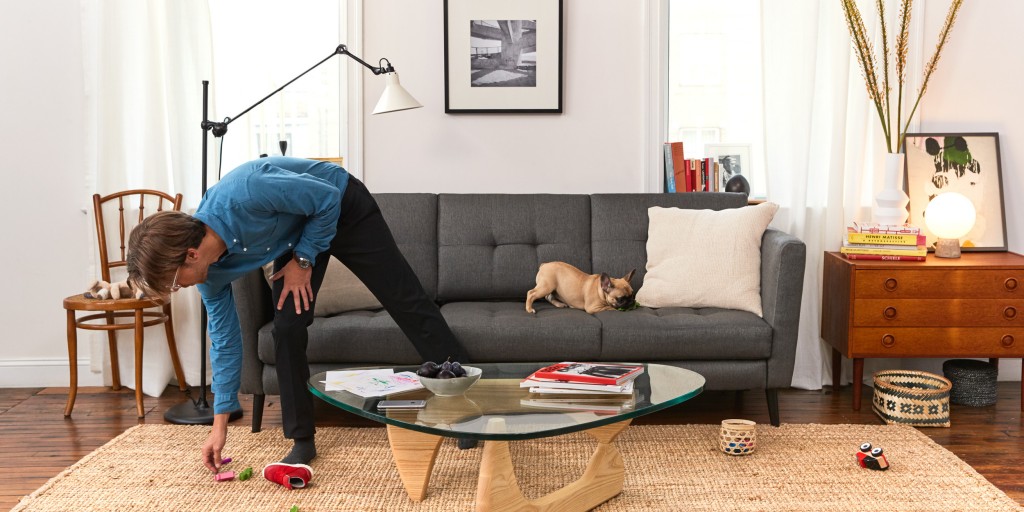Big Money: Burrow’s $4.3M seed points to a larger trend – VCs are warming up to emerging furniture brands.
NEW YORK — It would’ve been easy to think that with the shuttering of (VC-backed) Greycork this year — not to mention the general, capital intensive nature of the furniture category — that investors would’ve been hesitant to throw more money at young brands in the furniture space.
No one would’ve blamed them for exercising caution. And yet here we are, heading into Christmas, and two promising furniture companies — first Floyd ($5M from 14W and Brand Foundry), and now Burrow — have managed to raise two rather nice-sized rounds.
Proof that investor confidence is growing: Burrow just announced theirs, a $4.3M seed led by Red & Blue Ventures (a firm that invests in upstarts from the UPenn network from which Burrow co-founders Kabeer Chopra and Stephen Kuhl) yesterday. It’s the latest in a growing list of modern luxury upstarts outside of the apparel and accessories categories to attract serious institutional investment.
More to the point, Burrow’s raise also shows that investors are becoming more comfortable backing resource-heavy, manufacturing-reliant brands beyond the mattress space — as long as there’s traction and the model is working.
Stepping back for a second, three big market trends bode particularly well for Burrow:
- The first, according to a report from Fung Business Intelligence, a retail-focused research firm: Gens X and Y (Burrow’s core customer base) became the largest consumer cohort in the US furniture market in 2014, accounting for 61% of all sales. All told, between 2012 and 2014, that amounted to a considerable 185% jump in spending.
- The second: The US furniture market is forecasted to reach $111B in 2019.
- The third: As with most established industries, the furniture space has been slow to migrate to e-commerce; there’s ample room to grow and it’s expected to reach $32B in sales in 2018.
With these figures in mind, it’s easy to see how Burrow is nicely positioned to capitalize on where the furniture market is heading and certainly helps to explain why investors were encouraged to back them.
But again, traction was also a huge consideration. Co-founder Stephen Kuhl told us that since launching in April, Burrow’s now bringing in more than $500K in revenues per month, and is scaling at about 20% month-on-month. That was an immense help, he said. “[Investors] buy into consumer businesses like ours in theory,” he said, “but there’s really no rhyme or reason, typically, why consumer companies work. So a lot of investors just want to see traction. With a lot of these consumer brands like Tommy John or MM.LaFleur, once investors can see that there’s traction, that people like it, then they’re like, ‘Ok that’s the proof we need.’”
Fair enough. Still, that’s not to say that it was all smooth sailing. Greycork’s shuttering, for one, loomed large in discussions. “There have been a number of furniture startups in the past that have tried to tackle this problem and they’ve either failed or not gotten very big,” Kuhl said. Investors, in doing their research, knew all about these failed brands when Burrow pitched them.
Doing it better. But a big reason why Burrow launched this year was to address the failures of these very same companies. As Kuhl explained it, other upstarts simply graft the DTC model to selling standard furniture, without improving product design to make for a better shipping, assembly, and break-down process for the consumer.
They’re not, Kuhl said, really solving the biggest problem here which is shipping. “They also require you to be home for four hours in the middle of the day to have it delivered, then you’ve got to lug it up the stairs, and who knows if it’ll fit. They don’t really solve any of the other traditional challenges of the furniture industry.” More to the point, because they’re not thinking about or addressing this problem in the proper way, consumers aren’t convinced, which means that they’re then unable to produce venture-like returns in the space.
Burrow’s silver bullet. Their central mission, Kuhl explained, is to solve this vital last mile shipping problem––a conundrum that looms large over the furniture industry as it continues to migrate to online sales. “In the furniture industry, anyone who’s trying to provide a better experience at a lower cost, can’t do it by shipping traditional sofas. You have to literally reinvent the product to optimize it for shipping. That’s what we did.”
Our biggest insight on Burrow. In a way you could make the argument that Burrow’s created a new product category here. Yes, it’s direct-to-consumer sofas and love seats. But these are modular furniture pieces that are specifically designed to be shipped easily, and to be assembled and disassembled (in the process of moving) without tools and as easily as possible. For everything that Burrow is doing––great design for less, selling directly to shoppers online––this to us is easily the most impressive part of the company.






